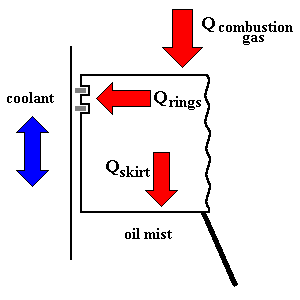 Figure 16. Piston Heat Transfer
Figure 16. Piston Heat Transfer
|

For the overall average heat transfer from the gas to the cylinder
coolant, convection type heat transfer equations are used.
 
Where:
-
Q = overall heat transfer (W/m2)
-
A = reference cylinder area (m2)
-
Tgas = effective gas temperature, typically 800 C
-
Tcool = coolant temperature, typically 80 C
-
h= heat transfer coefficient
The heat transfer coefficient depends on the engine geometric parameters,
such as the exposed cylinder area and bore, and piston speed. The coefficient
varies with location and piston position. The coefficient is found from
a Nusselt - Reynolds number correlation.
Nusselt # = a (Reynolds #)m

Where:
-
b = cylinder characteristic length (m), usually chosen to be the
cylinder bore.
-
k = gas thermal conductivity, (W/mK), typical value 0.06
-
v = gas thermal diffusivity, (m2/s), typical
value 100 x 10-6
-
U = characteristic gas velocity (m/s)
Depending on the correlation used, the characteristic gas velocity U
is the mean piston speed

the average intake velocity

or a combustion velocity. The coefficient a and exponent m are found
from engine experiments. There are three types of heat transfer coefficients
used in the computation of engines heat transfer.
Table III. Types of Heat Transfer Coefficients
|
Averaging |
Used for |
| h(x,t) |
averaged over time & space |
overall steady state energy balance calculations |
| h(x,t) |
instantaneous, space average |
heat transfer versus crank angle |
| h(x,t) |
instantaneous, local |
local calculations of thermal stress |
The peak values of the instantaneous and local coefficients can be many
times higher than the averaged values.
A frequently used correlation for an average h is that of Taylor (ref),
which uses the mean piston speed for the characteristic velocity.

For a 1000 rpm engine with a 0.1m stroke, combustion gas temperature
of 1000C, and coolant temperature of 80 C


The average heat transfer per unit area from the cylinder to the coolant
is

For a reference cylinder area of p b2/4,
the average heat transfer is

|






